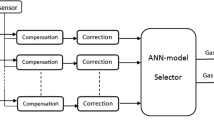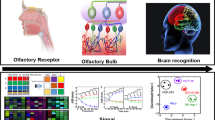Abstract
An artificial olfactory, which is called an electronic nose system (e-nose), is studied for realizing new human–machine interface. The system consists of sensor unit and a signal processing unit. There are some types of sensors for the sensor unit, metal oxide semiconductor gas sensors (MOGS) and quartz crystal microbalance gas sensors are useful in our study. Our system in this paper has MOGS. Many of MOGS utilize an effect of an oxidation–reduction reaction on the surface of the sensors. One of the features of the sensor, the character of the sensor is changed by temperature of the sensors. In this paper, we build a extend output sensor unit using this feature, and show experimental result of classification applying multilayer perceptron. In the experiment, we choose soy sauce as classification targets because we are considering applying the system for management of cooked foods.












Similar content being viewed by others
References
Sakairi Minoru et al (2009) Olfaction presentation system using odor scanner and odor-emitting apparatus coupled with chemical capsules of alginic acid polymer. IEICE Trans Fundam. E92-A(2):618–629
Hidehito Nanto, et al. (2002) Discrimination of Types of Japanese Sake Using “Kansei” chemical Sensor System, Technical report of IEICE, OME2002-41, pp 19–23
Daigo Hayashi, et al. (2012) Odor ClassificationbyNural Network, Proceedings of the 56th Annual Conference of the Institute of Systems, Control and Information Engineers (ISCIE), pp 633–634
Munoz Severino et al (2002) Study of quartz crystal microbalance odor sensing system for apple and banana flavors. IEICE Trans Electron E85-C(6):1291–1297
Schaller E et al (1998) ‘Electronic Noses’ and their application to food. Lebensm-Wiss. U-Technol. 31:305–316
Peris Miguel et al (2009) A 21st century technique for food control: electronic noses. Anal Chim Acta 638:1–15
Loutfi Amy et al (2015) Electronic noses for food quality: a review. J Food Eng 144:103–111
Liu Xiao et al (2012) A Survey on Gas Sensing Technology. Sensors 12:9635–9665
Arshak K et al (2014) A review of gas sensors employed in electronic nose applications sensor review. Emerald 24(2):181–198
Banica FG (2012) Chemical Sensors and Biosensors: fundamentals and applications, 1st edn. Wiley, Hoboken
H Araki et al. (2015) Olfactory sensor system with variable voltage power units for a heater and sense circuit of metal oxide semiconductor gas sensor. In: Proceedings of the International Symposium on Artificial Life and Robotics (AROB20th), Beppu, Oita, pp 470–473
Author information
Authors and Affiliations
Corresponding author
About this article
Cite this article
Araki, H., Oura, M. & Omatu, S. An evaluation of an olfactory sensor and recognition system using metal-oxide semiconductor gas sensor with variable heater controller. Artif Life Robotics 23, 73–79 (2018). https://doi.org/10.1007/s10015-017-0403-0
Received:
Accepted:
Published:
Issue Date:
DOI: https://doi.org/10.1007/s10015-017-0403-0




